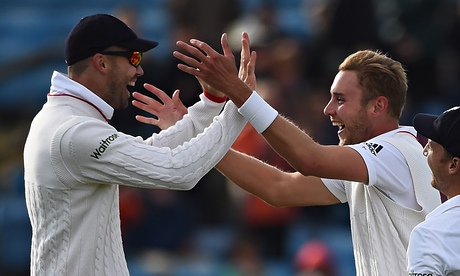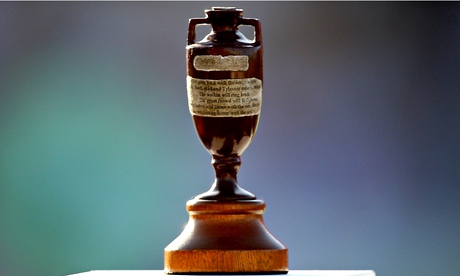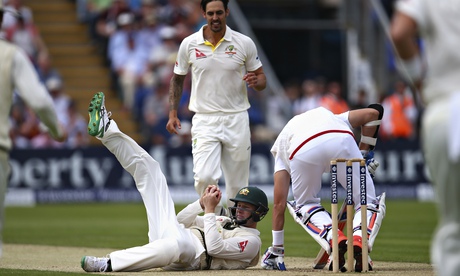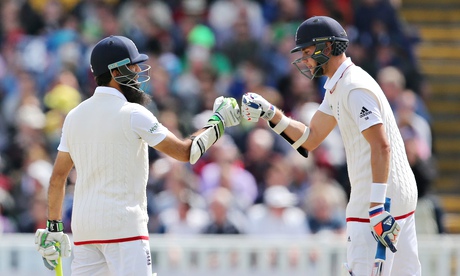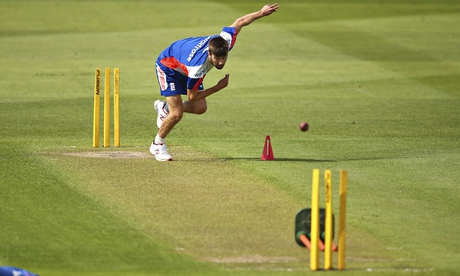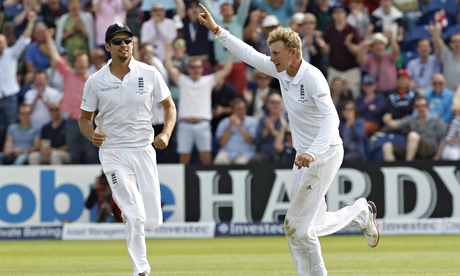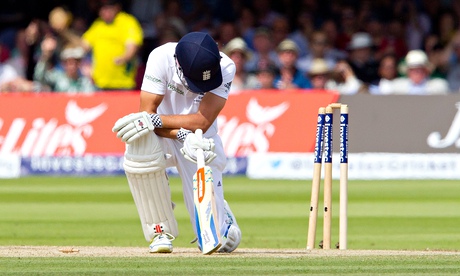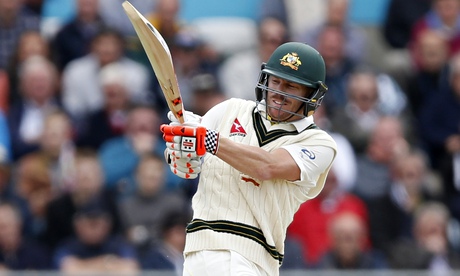It was coming towards the end of a long hot Antiguan day, the final one of the first Test in April, and Jimmy Anderson, in his 21st over, was searching for the wicket that would give England a chance of winning the match, and at the same time, make him his country’s leading Test wicket-taker. It was getting irritating. Jason Holder and Denesh Ramdin had been batting for the past 32 overs, adding 105 for the seventh wicket to frustrate England. The pitch was slow, offering little, and the second new ball already more than 30 overs old.
Before the over started Anderson, wearying, had walked back to his mark and engaged in conversation with Stuart Broad, standing at mid-off.
“Try some leg cutters,” Broad said, “hold the seam straight down rather than across, fingers alongside and just rip it.” So Anderson gave it a go. The first one, to Ramdin, failed to grip on the pitch and held its line, and the batsman, a half-century to his name already, defended it easily enough on off stump. Anderson tried again. This time the seam caught the ground, the ball deviated away from Ramdin’s defensive prod, took the outside edge, and Alastair Cook made a tumbling catch at first slip. Anderson wheeled away in triumph.
Afterwards, Anderson acknowledged the part that his bowling partner had played in creating the record-breaking delivery. Bowling can be a solitary occupation but within that it can also be collaborative. Broad’s habitual position at mid-off or mid-on when Anderson is bowling, and that of Anderson in the same positions when Broad is operating, are significant, at odds with the customary pace bowlers’ post-over stroll to fine leg to graze and catch breath. The pair are in constant communication, and, as with the leg-cutter, bounce ideas from one to the other, communicating them through to Cook in his executive role.
That fast bowlers hunt in pairs (leaving aside the exception of the West Indies side of the decade from mid-70s to 80s, who operated as an interchangeable pack) is one of the cliches of cricket. Some have become such that one bowler tends not be mentioned without the other: Trueman forever allied with Statham; Lindwall with Miller; Larwood and Voce; Hall and Griffith, Lillee and Thomson; Botham and Willis; Donald and Pollock; McGrath and Gillespie; and so on. Some are simply identified by first names, or even abbreviations, alone: Waz ’n’ Waqar; Curtly and Courtney. It will never be Jimmy and Stuart, butBroad and Anderson (somehow it trips off the tongue better that way round) should be included in the list.
When they do so in Cardiff, no pair of England bowlers will have taken the field with more wickets between them than their 676, already 56 more than the total Botham and Willis had accrued by the end of the latter’s final Test in 1984. In matches they have played together, Anderson and Broad have taken 569 wickets – 296 to Anderson, 273 to Broad – which means a further 11 will see them overtake the Botham-Willis alliance.
Partnerships such as this work in separate but distinct ways. The collaborative element, the sharing of information and ideas, is an important one but so too is the competition that such a relationship can create.
A personal illustration might be the couple of years at Middlesex when I opened the bowling with Allan Jones. We were friends, travelled to matches together, shared a beer together. But he knew, because I told him, that although I enjoyed his success and the contribution it made to the team effort, part of me still begrudged him every wicket he got because it was one fewer for me to try to take. It would be unusual if Broad and Anderson did not harbour similar sentiments.
Broad may be entitled to feel more than a little miffed at the perception of the relative values of the two when it comes to the England team. In the leadup to this Ashes series much has been made of the importance of Anderson, and his use of the new ball, to any possible England success. For some years, it is Anderson whose brilliance is seen as being absolutely integral to England, and there is no question he has earned his place in the pantheon of great England cricketers. Broad, on the other hand, is viewed as mercurial, inconsistent, off the pace all too often, and not infrequently the source of public opprobrium. Where Anderson’s place is inviolate, Broad’s often appears to be hanging by a thread.
Look at the records of the two bowlers over the past two and a half years. Between them, they have taken fractionally more than half of England’s 459 wickets in that time. But which of them has taken most and at what cost? The answer to the first part is neither: since new year, 2013 Anderson and Broad have both taken 115 Test wickets. They have done so at an average, for Anderson, of 27.00, and for Broad, of 26.53. Anderson has taken five wickets in an innings on five occasions and had a single 10-wicket match, the Trent Bridge Test at the start of the last Ashes series here. Broad, though, has seven five-wicket hauls in that same period and a 10-wicket match at Chester-le-Street in that same Ashes series. Anderson’s Nottingham haul, and that of Broad in the north-east, were huge contributing factors in the two victories that secured that series.
It may not be how the cricket public perceives it but the Broad and Anderson partnership is one of equals.
How the Ashes pace attacks compare
ENGLAND
Jimmy Anderson England’s highest wicket-taker and part of a formidable duo with Stuart Broad. When the ball swings and he can pursue a full length, there is no finer bowler in the world, his command of the ball mesmerising. Also dangerous when reversing the old ball. Has to work a lot harder for wickets when there is no lateral movement. Unusually, his default to left-handers is to swing the ball away from them rather than challenge the pads.
Stuart Broad A counterpoint to Anderson. Broad can have quiet periods and then suddenly will get on a roll when wickets seem an inevitability. He has been successful when bowling a fuller length but it does not naturally suit the arc of his swing and can tend to float. When under pressure, he tends to drop his length back. Not a huge swinger of the ball, but height lends him bounce and he has an excellent bouncer.
Mark Wood Can be rapid and a relative lack of height means he is a skiddy bowler. With a short run and explosive action, he tries to bowl a full length from which he can swing it, similar to Simon Jones. He is an excellent exponent of reverse swing which will be important if the weather stays dry. He has played few first-class matches and, coupled with injury, there is a question mark over his stamina: after an excellent debut Test at Lord’s he was off the pace at Headingley. Will need careful management.
Steven Finn Starting to get some confidence back after a trying two years. He is still not back to the sort of devastating pace he showed in India and New Zealand three years ago. There are kinks in his action that persist but he is still pacy enough to cause problems. He retains the capacity to take wickets and may well be used during the series.
Liam Plunkett Tall, willing, fast at times, and extremely fit. He too can exploit a fullish length, targeting the top of off stump, but in the past has been used to rough up the opposition as well. Like Finn, he could well be used on a rotational basis, if not during this series then in the next six months. Not involved at Cardiff but in England’s thoughts.
AUSTRALIA
Mitchell Johnson Nothing more than a simple change to the angle of his approach transformed him from a figure of fun to a world-class bowler to be feared. Probably the fastest bowler in the world now, he will play a huge part in targeting England’s lower order. Can have his confidence dented, though, and has an unhappy experience of bowling in England. Rarely swings the ball into the right-hander intentionally but occasionally it clicks into place. His low delivery arm means his bouncer skids nastily.
Mitchell Starc Has the potential to be the bowler of the series now that Ryan Harris has been ruled out. A tall, pacy left-armer who swings the ball into the right-hander and will have noted the success of Trent Boult earlier in the summer. He will enjoy bowling to England’s plethora of left-handed batsmen.
Josh Hazlewood Tall, accurate and quick enough, he may take time to adjust his length to the demands of bowling over here. Once he has done so, he could well complete a formidable pace trio with Johnson and Starc. Comparisons are inevitable: for Hazlewood it is with Glenn McGrath.
Peter Siddle An absolutely indefatigable right-armer who for the cause will bowl until he drops, pick himself up and go some more. If Hazlewood cannot yet be trusted to do the stock job, then there is no one better than Siddle. Having said this, his pace is said to be down on what it once was.
Pat Cummins Called into the squad following the departure of Harris. He was first selected when 18, the youngest Australia debutant for six decades, and immediately took six wickets against South Africa. Only 22, he has suffered serious injury and has not played a first-class match for almost a year and six only in his career.
